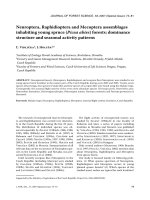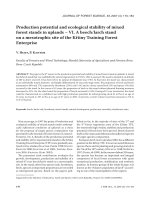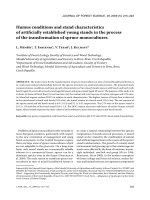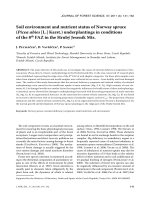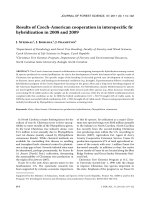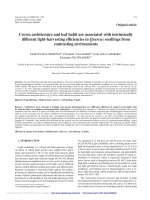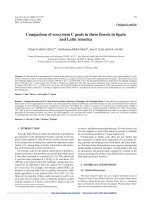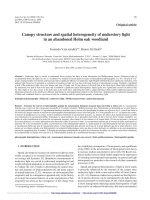Báo cáo lâm nghiệp: "Tree density and site quality influence on Pinus halepensis Mill. reproductive characteristics after large fires" pdf
Bạn đang xem bản rút gọn của tài liệu. Xem và tải ngay bản đầy đủ của tài liệu tại đây (423.57 KB, 8 trang )
Ann. For. Sci. 64 (2007) 649–656 Available online at:
c
INRA, EDP Sciences, 2007 www.afs-journal.org
DOI: 10.1051/forest:2007043
Original article
Tree density and site quality influence on Pinus halepensis Mill.
reproductive characteristics after large fires
Daniel Moy a
a
*
,JosepM.E
spelta
b
, Iraima Verkaik
b
,FranciscoL
´
opez
-Serrano
a
,
Jorge
de las Heras
a
a
Escuela Técnica Superior de Ingenieros Agrónomos de Albacete, Universidad de Castilla-La Mancha,
Campus Universitario s/n. 02071 Albacete, Spain
b
CREAF (Centre for Ecological Research and Forestry Applications), Universidad Autonoma de Barcelona 08193 Bellaterra, Spain
(Received 29 November 2006; accepted 24 January 2007)
Abstract – In Spain, many Pinus halepensis Mill. forests have been seriously affected by significant forest fires in the past decade, in 1994 alone, more
than 100 000 ha were burned in Eastern Spain. In order to study the reproductive characteristics of P. halepensis after forest fires, six locations were
selected in four areas affected by serious fires in the summer of 1994, and the following different precipitation zones were studied: dry-subhumid, dry
and semi-arid. Ten years after the fires, data relevant to the production of pine cones: serotinous (grey), mature (brown), immature (green) and opened
cones, was collected from areas with natural post-fire regeneration. Various cone and seed characteristics, such as pine cone seed number and weight,
and germination percentage, were measured. The results showed greater production of cones and strobili in high-density sites. The biggest cone sizes
(volume) and seed number per cone were related to site quality (dry-subhumid precipitation zone). Also, viability and germination percentages were
higher with better site quality, with significant differences in values for serotinous and non-serotinous cones. Despite these differences, the canopy seed
bank was large enough to ensure regeneration in this area for this age stand.
Pinus halepensis / serotiny / canopy seed bank / natural regeneration
Résumé – Influence de la densité du peuplement et de la fertilité de la station sur la dynamique de reproduction de Pinus halepensis Mill.,
dix ans après d’importants incendies. En Espagne, dans les dix dernières années, de nombreuses forêts de Pin d’Alep ont été gravement touchées
par d’importants feux de forêt. Rien qu’en 1994, plus de 100 000 ha ont brûlé dans l’est de l’Espagne. Dans le cadre d’une étude de la dynamique de
la reproduction du Pin d’Alep après incendie, six sites, situés dans des zones de feux de forêt survenus lors de l’été 1994, ont été observés. Ces sites
présentent des niveaux de précipitations différents : sec à sub-humide, sec et semi-aride. Dix ans après incendie, des données concernant la production
de cônes de pin : sérotineux (gris), mûrs (marrons), immatures (vert) et cônes ouverts, ont été collectées dans des zones de régénération naturelle.
Diverses caractéristiques des cônes et des graines ont été relevées : nombre et poids des cônes et des graines, taux de germination. Les résultats révèlent
une production importante de cônes et de strobiles dans les sites à forte densité de pin. Le volume des cônes et le nombre de graines par cône étaient
liés à la fertilité de la station (zone sèche à sub-humide). Les taux de viabilité et de germination étaient aussi plus importants dans les zones présentant
le plus de précipitations et des écarts significatifs ont été observés entre les valeurs de cônes sérotineux et non sérotineux. Malgré ces différences, les
banques de graines dans les peuplements étaient suffisamment importantes pour assurer la régénération du pin dans cette zone.
Pinus halepensis / sérotine / banque de graines de la canopée / régénération naturelle
1. INTRODUCTION
The Mediterranean Basin is an intensely anthropized area
where forest fires are associated with the landscape. This is
one of the principal factors determining the mosaic-like char-
acter of the Mediterranean landscape [1, 30, 32, 35]. Recurrent
fires can prompt adaptations and influence forest development,
especially in Pinus halepensis Mill. [4, 30]. Aleppo pine is a
widely distributed conifer in the Mediterranean Basin which
is well-known as an obligatory seeder and for its ability to
grow in difficult environmental conditions [46] such as burned
sites and open spaces where no competing species grow [10].
When a fire occurs, the adult plants die and their regeneration
is entirely dependent on the canopy-stored seed bank. Massive
* Corresponding author:
germination, triggered by fire-related factors such as heat or
smoke [14, 26] and influenced by the first winter rains after a
fire [31], can result in dense pine stands developing throughout
the burned area [21].
In areas with frequently recurring fires, early flowering is
necessary for successful post-fire colonization, and there are
several studies that have recorded flowering in five-year-old
stands [7, 41, 42]. Also it has been suggested that forest age,
tree density, environmental conditions and site characteristics
contribute to variations in the number of cones produced [21,
43].
Serotiny is common in pine species growing in ecosystems
affected by fires [2, 45]. Seeds stored in serotinous cones are
released after a fire and take advantage of post-fire condi-
tions to germinate their seeds and establish seedlings [23, 25].
Article published by EDP Sciences and available at or />650 D. Moya et al.
Figure 1. Sites location in the Iberian Peninsula
In Aleppo pine, a dual strategy with two different types of
seeds for different scenarios has been described [28, 29]. The
serotiny level of pine stands must be taken into consideration
because research reports that serotinous and non-serotinous
cones appear simultaneously, with their proportion related to
several factors, including size, age and tree density [24]. In
one strategy, seeds germinate from non-serotinous cones un-
der warm and dry weather conditions, and in the other, they
develop from serotinous cones that release their seeds after fire
because serotinous cones open at high temperatures and low
relative humidity. However, many of these serotinous cones
may also open given certain special conditions such as dry
spell or dry winds [23]. Germination can be affected by many
factors such as high temperature [17], ash presence [33], ni-
trogen content [5] and litter cover, among others. Furthermore,
germination responses show differences depending on whether
seeds are from serotinous or non-serotinous cones. Pine prove-
nance must also be regarded as an important factor in deter-
mining germination [9].
The increase in forest fires in the Iberian Peninsula in the
past decade has increased the distribution of P. halepensis, es-
pecially in Eastern areas, as in other areas of the Mediterranean
Basin affected by recurrent forest fires [22, 27].
Differences in cone production, growth and foliate nutri-
ents [20, 34] have been described for different fires and dif-
ferent locations. However, there is not sufficient knowledge
concerning differences in cone production depending on site
quality or tree density due to the difficulty in finding similar
regeneration scenarios.
The natural and artificial extension of P. halepensis forests
and the increase in the number of fires and burned areas in
Spain makes it necessary to know what differences exist in the
main reproductive characteristics such as canopy seed bank
storage, the number of immature cones and germination ca-
pability. This information provides knowledge on the current
status of different reproduction responses observed according
to density and site quality. Also, these results give an idea of
the possible future development of pine stands. The reproduc-
tive characteristics selected were based on the measurement
of variables commonly used in similar studies: the number of
strobili and cone types [24]; cone weight and volume and seed
number per cone [44]; and the number of sound seeds, via-
bility and germination rates [12, 43]. If a new fire occurred
before the tree reached the reproductive phase, post-fire nat-
ural regeneration might be deficient [10, 43] which produces
important environmental impacts as risk of soil loss, loss of
biodiversity, loss of carbon sink, etc. This information could
be very useful for foresters when making management deci-
sions, for example in applying silvicultural treatments in the
early stages of regrowth [13].
In 1994, four serious forest fires occurred in Eastern Spain,
in which 100 000 ha were burned. Each of these forests primar-
ily affected mature Aleppo pine trees and, as shown in previ-
ous studies, monospecific Aleppo pine forests usually return to
their original state after a fire [6]. The present paper conducts a
study of natural Aleppo pine regeneration 10 years after a fire
event (in areas of similar age and environmental conditions), in
order to evaluate cone and seed characteristics, as well as the
canopy-stored seed bank depending on differences in climate
and tree density.
2. MATERIALS AND METHODS
2.1. Study Site
The study was carried out at six sites located in four different
areas affected by large forest fires in the summer of 1994 and dis-
tributed from N to S in Eastern Spain (Fig. 1). Two of these fires
occurred in the provinces of Barcelona and Tarragona (NE Spain),
where 50 000 ha and 12 500 ha were burned, respectively, and the
other two in the provinces of Albacete and Murcia (SE Spain), where
14 000 and 30 000 ha were burned. In all of these areas, natural regen-
eration resulted in high-density stands of Aleppo pine (90% of the to-
tal burned surface two years after the fire), although final density var-
ied [21, 47]. There were several similarities in all six sites: coverage
by mature Pinus halepensis forests; stand age (10 years old); years
since the two most recent fires (in 1994 and over 40 years without a
forest fire, respectively), as demonstrated by old aerial photographs
and land use maps.
The main soil characteristics were similar in all areas studied: car-
bonated substratum, pH values between 8.5 and 8.7 and low slope
(< 5%). Climate and resource availability (with water shown to be
the most significant) were considered the principal factors influencing
dependent variables. In addiction, conifers have developed adaptive
strategies for drought [3, 19]. Therefore, site quality (which includes
all of the above parameters) is considered the main factor influencing
variations in stand development variables.
2.2. Experimental design
Six sites were selected in areas affected by significant fires in the
summer of 1994. The sites were located in Cardona (CAR), Súria
(SUR), Tarragona (TAR), Yeste (YES) and Calasparra (CAL). They
were distributed along the Eastern Iberian Peninsula (Fig. 1). Growth
and reproduction characteristics were studied in 24 plots located
Aleppo pine reproduction after large fires 651
Figure 2. Cone production (X axis:
site; Y axis: number of cones
per Ha). Pointed bar: strobili (first
year cones); dark grey bar: imma-
ture cones (green); soft grey bar:
mature cones (brown); white bar:
serotinous cones (grey); black bar:
opened cones.
Table I. Summary characteristics of the study sites. NP: Number of plots; COORD: Geographical coordinates (WGS 84 datum); BS: total
burned surface (ha) in 1994; D: Density (trees ha
−1
± SE); A: Altitude (m); P: average annual rainfall (mm ± SE); T: annual temperature
(
◦
C ± SE); CL: ombroclimate (Thornwaite index).
Site NP COORD BS D A P T CL
CAR 3 41
◦
55’ N; 1
◦
41’W 25 000 53 221 ± 1 427 530 798 12.0 Dry-sub humid
SUR 3 41
◦
49’ N; 1
◦
42’ W 25 000 32 722 ± 2 902 510 756 11.5 Dry-sub humid
TAR 7 40
◦
46’ N; 0
◦
17’ W 12 500 25 187 ± 1 713 350 659 13.6 Dry-sub humid
TUS 5 38
◦
22’ N; 2
◦
24’ W 14 000 61 145 ± 389 1010 600 13.0 Dry
YES 3 38
◦
20’ N; 2
◦
20’ W 14 000 7 089 ± 468 900 530 12.7 Dry
CAL 3 38
◦
16’ N; 1
◦
38’ W 30 000 62 669 ± 956 325 290 16.5 Semiarid
within the sites. Each site represented a different stand tree density
and climate conditions (Tab. I). They were located randomly within
the sites and were circular in design (r = 10 m; 350 m
2
). Each plot
consisted of trees from natural, post-fire regeneration over an eco-
logically homogeneous area. In each plot 20–25 trees were randomly
selected to be monitored and measured throughout 2004.
Local tree density was estimated for each plot by counting the
total number of trees. Site quality was quantified by measuring the
dominant height in each site (average height of the 100 tallest trees
per ha). In this study, due to the small plot area, we selected the av-
erage of the two highest trees. Dominant height is strongly correlated
to annual rainfall in these sites (Logarithm-X regression, p < 0.01,
correlation = 0.6271 and R
2
= 39.95%), which demostrates that it
is an accurate indicator of site quality. Sites were grouped, accord-
ing to latitude and average annual rainfall, as northern dry sub-humid
(CAR, SUR and TAR), southern dry (TUS and YES) and southern
semi-arid (CAL) precipitation zones [36]. So the study compared six
different values for tree density and three for site quality distributed
along Eastern Spain.
2.3. Measurement of reproductive characteristics
Fertilized cones were counted and classified based on appareance
and age (counting whorls over the insertion point) as: green or im-
mature (less than two years old), brown or mature (two to three-year-
old cones), grey or serotinous (four years old or older) and opened
cones. This classification is based on previous studies [24, 44]. For
the purpose of this study serotiny is regarded as the proportion of the
total number of cones produced during a tree’s lifetime which remain
closed after maturation.
The total number of cones produced was regarded as the number
of mature, serotinous and opened cones. The reproductive character-
istics studied are based on records from mature and serotinous cones.
Reproductive characteristic measurements were taken at the se-
lected sites, with the exception of viability and germination percent-
ages at the TUS site. For this purpose six mature and serotinous cones
were collected from the lower, external part of the tree crown [40,44]
outside each experimental plot. Once in the laboratory, the volume
of each cone was measured by immersing cones in water in a test
tube (accuracy to 0.01 mm
3
). Sample cones were kept in boiling wa-
ter for one minute and then oven-dried at 45
◦
Cfor48hinorderto
open them. Seeds were manually extracted and counted in each cone
to obtain the number of seeds per cone (separated for cone type and
study site). Average cone weight was calculated by weighing cones
in a balance (accuracy to 0.01 ± 0.01 g).
The percentage of sound and unsound seeds per cone was calcu-
lated by a cutting test, wherein a sample of 50 seeds were cut and ob-
served. Those which were morphologically mature (germ and reserve
652 D. Moya et al.
tissues look healthy) were classified as sound and the others as un-
sound (empty or unhealthy appearance) [12]. Viability percentage
was calculated applying the Tetrazolium method [11] to the sound
seeds. Four replicates of 25 seeds each were randomly selected for
each site and cone type (mature or serotinous), and placed in petri
dishes. The seeds were continuously watered to maintain the required
humidity level. The germinators were kept in a germination chamber
at a constant temperature of 20±0.5
◦
C with a 14-h photoperiod [43].
Germination (seeds with a geotropic radicle longer than 2 mm) was
recorded every 2–3 days for 35 days. Germinated seeds were recorded
and subsequently removed [9].
After the germination period, non-germinated seeds were cut open
to establish the number of sound and unsound seeds (unsound seeds
were not used to calculate the germination percentage). The results
were expressed as the percentage of sound seeds (mean number of
sound seeds out of the total number of cut seeds), viability percentage
(mean number of coloured seeds out of the total treated seeds) and
germination percentage (percentage of sound germinated seeds in the
petri dishes).
Canopy seed bank was defined as the number of viable seeds
per hectare and was estimated separately for seeds from mature and
serotinous cones from each plot [24]. It was calculated as the product
of: the average number of cones per hectare, the average number of
seeds per cone and the average percentage of viable seeds. The num-
ber of seeds per cone was defined as the average number of sound
seeds contained in each cone and was calculated by multiplying the
average number of seeds per cone and the percentage of sound seeds,
depending on the cone type for each site.
To estimate the canopy seed bank storage, two classes were estab-
lished: SSB: serotinous seed bank density (considering seeds from
serotinous cones) and MSB: mature seed bank density (seeds from
mature cones). Canopy seed bank (CSB) store was obtained by
adding the values for these two classes. The results for canopy seed
bank are only valid for the current year (2004) because the next year,
cones will have undergone changes: immature cones will ripen (and
therefore be included with the mature cones) and mature cones could
either become serotinous or opened cones. Serotinous cones could
also open or remain closed.
2.4. Statistical analysis
For all statistical analyses data were transformed using log or
√
arcsine transformations to achieve normality assumptions and ho-
moscedasticity. The data shown in the tables and figures have not
been transformed, standard errors (± SE) are included. Simple and
Multiple ANOVA were used to test differences, and Fisher’s Least
Significant Difference (LSD) procedure was used to compare mean
values. The relationship between dependent variables and factors was
tested using the General Linear Model (GLM) expressed as an equa-
tion containing the sum of the independent variable values, plus a
term for all unknown factors (error term). In cases where there was
a relationship between two variables, only a simple regression test
was performed. The Kruskal-Wallis test was used to check median
significant differences between independent variables. All statistical
analyses were conducted using a critical p-value of 0.05.
PCA was carried out using tree density, number of seeds per cone,
site quality, volume and weight per cone, viability, germination and
sound seed percentage as variables. The purpose of the analysis was
to obtain relationships for the parameters studied. In this case, the first
two components account for 56.41% of the variability in the original
data.
3. RESULTS
3.1. Cone production
Strobili production was higher in TUS (33 295.4 ±
1 702.7 strobili ha
−1
), although in general the annual crop
was very low for this site (Fig. 2). The number of serotinous
cones was significantly higher in CAR and CAL. For other
cone types the highest cone production was recorded in CAR
(9 779.3 ± 1 902.18 immature cones ha
−1
, 7 086.7 ± 2 980 ma-
ture cones ha
−1
and 10 571 ± 4 307 serotinous cones ha
−1
)
and the same pattern was observed in open cones (2 088 ±
208 opened cones ha
−1
). It is also significant that TUS and
CAL did not produce any open cones.
An analysis of factors related to cone production revealed
a positive correlation between total cone production and pine
tree density (p < 0.01; F
2
= 51.61). MANOVA showed
a significant relationship between tree density and immature
(p < 0.01, F = 30.19) and serotinous (p < 0.01, F = 2 916)
cones. Also a significant correlation was found between site
quality (p < 0.01, F = 11.52) and the number of open cones
per hectare (p < 0.01; F
2
= 32.60).
3.2. Cone and seed characteristics
Mean values and significant differences for each site are
shown in Table II and the interaction from GLM can be seen
in Table III.
Cone volume and the weight of mature cones did not
present significant differences at different sites. However,
CAR, SUR and TAR presented higher numbers of seeds per
mature cone.
Average cone weight did not vary significantly at different
sites, as is the case for mature cones, but CAR, SUR and TAR
showed significantly higher values for serotinous cones.
Average cone volume and weight did not present differ-
ences for cone type (mature or serotinous) and non-interactive
factors were recorded. Furthermore, a significant interaction
with respect to the number of seeds per cone was found, with
the significant factors being cone type and tree density
Significant differences were found in the percentages of
sound seeds per cone (Fig. 3). The highest values were reached
in YES (87.78 ± 2.78 and 87.60 ± 2.41% for mature and
serotinous cones respectively) and the lowest values were in
CAL (51.67 ±25.87% for serotinous cones) and TAR (69.12 ±
5.68% for mature cones).
In general, the results showed a high germination percent-
age in the sites studied (more than 74%, with the exception of
CAL) and viability percentage values fluctuated from 95.53 ±
1.45% and 93.17 ± 0.71% in SUR to 59.72 ± 12.75% and
68.33 ± 0.50% in CAL (for seeds from mature and serotinous
cones, respectively) (Fig. 4).
Aleppo pine reproduction after large fires 653
Table II. Cone Characteristics for serotinous and mature types. V: mean cone volume (mm
3
) ± SE; SN: mean number of seeds per cone ± SE;
W: mean cone weight (g) ± SE. Small letters mean significant differences (LSD method) among sites at p < 0.05.
Site
Serotinous cones Mature cones
VSNW V SN W
CAR 16.03 ± 1.25
a
84.53 ± 4.94
a
16.50 ± 0.81
a
17.19 ± 1.13
b
101.44 ± 8.03
a
14.61 ± 0.33
a
SUR 11.80 ± 0.47
b
75.02 ± 4.97
a
15.81 ± 0.37
b
9.75 ± 0.91
c
94.72 ± 2.23
a
10.00 ± 0.58
b
TAR 17.99 ± 1.53
a
92.66 ± 3.73
a
13.48 ± 1.35
a
19.02 ± 1.99
a
109.64 ± 6.04
a
10.57 ± 1.51
a
TUS 16.72 ± 2.38
a
58.50 ± 5.50
a
15.47 ± 1.84
c
15.61 ± 1.45
b
50.50 ± 18.50
a
14.64 ± 2.41
d
YES 11.89 ± 1.52
b
72.00 ± 8.62
a
14.25 ± 0.95
b
21.82 ± 6.55
a
74.78 ± 3.13
a
14.51 ± 3.25
c
CAL 8.60 ± 2.61
c
48.28 ± 7.80
a
11.35 ± 4.71
c
9.42 ± 1.47
c
67.89 ± 19.07
a
12.71 ± 1.82
d
Figure 3. Mean percentage of sound seeds per cone (X axis: site;
Y axis: percentages). White bar: mature cones; grey bar: seroti-
nous cones. Small letters mean significant differences (LSD method)
among sites at p < 0.05.
Figure 4. Seed viability from tetrazolium method (X axis: site;
Y axis: percentage). White bar: mature cones; grey bar: seroti-
nous cones. Small letters mean significant differences (LSD method)
among sites at p < 0.05.
Average germination percentage values (Fig. 5) were sig-
nificantly higher in the more northern sites (CAR and SUR),
although values were exceptionally high in TUS (almost
100%). Significantly low values were found in CAL (65.00 ±
3.33% and 51.94 ± 17.71% for seeds from serotinous and ma-
ture cones, respectively). The GLM showed that viability ex-
perienced significant interactions by the site quality factor, so
Table III. GLM was applied to reproductive characteristics (RCh).
GLM provides regression analysis and analysis of variance for one
dependent variable (each RCh variable) by one or more independent
factors. Categorical variables are accepted in this tool so dummy vari-
ables are not manipulated. Significant models are bold written and
significant factor (for the analyzed variables) are italic written. * In-
dicates significant models and interactive factors (p < 0, 05).
RCh p-value R
2
Factor p-value
Volume 0.09 16.51
Weight 0.21 11.80
Full seed 0.25 10.79
Germination 0.35 13.03
Cone type 0.85
Viability 0.03* 31.73 Density 0.36
Site quality < 0. 01*
Cone type 0.04*
Seed number < 0.01* 28.79 Density 0.08*
Site quality < 0. 01*
Figure 5. Seed germination (X axis: site; Y axis: percentage).White
bar: mature cones; grey bar: serotinous cones. Small letters mean sig-
nificant differences (LSD method) among sites at p < 0.05.
simple regression was applied. The best correlation was ob-
tained using an X-inverse model (p < 0.01, R
2
= 62.17,
F = 41.08; CC = –0.79).
PCA analysis (Fig. 6) showed the correlation between fac-
tors and variables. It is clear that the number of sound seeds
was correlated with tree density. Germination percentage
654 D. Moya et al.
Table IV. Aleppo pine cone crop (serotinous and mature) in the study sites and canopy seed bank in summer 2004. SC: serotinous cones per
ha ± SE; MC: mature cones per ha ± SE; AC: annual cone crop per ha ± SE; SSB: serotiny seed bank per ha ± SE. MSB: mature seed bank
per ha ± SE.; CSB: canopy seed bank per ha ± SE. Small letters mean significant differences (LSD method) among sites at p < 0.05.
Site SC MC AC SSB MSB CSB
CAR 10 500 ± 4 000 7 000 ± 3 000 17 500 ± 6 000
a
375 000 ± 225 000 550 000 ± 250 000 925 000 ± 450 000
a
SUR 2 500 ± 575 700 ± 100 3 200 ± 350
c
160 000 ± 40 000 15 000 ± 15 000 175 000 ± 30 000
c
TAR 4 000 ± 2500 600 ± 375 4 600 ± 550
c
–– –
TUS 1 700 ± 150 2 000 ± 1 275 37 00 ± 1 250
c
180 000 ± 18 000 670 000 ± 575 000 850 000 ± 750 000
b
YES 1 500 ± 700 1 500 ± 1 000 3 000 ± 1 000
c
75 000 ± 35 000 50 000 ± 35 000 125 000 ± 55 000
d
CAL 9 000 ± 7 500 4 000 ± 2 500 13 000 ± 5 000
b
270 000 ± 200 000 90 000 ± 45 000 360 000 ± 185 000
c
Component 1
Component 2
Vcone
Ns eed
Wc on e
Sound
Viab
Germ
D
QS
-4.8 -2.8 -0.8 1.2 3.2 5.2
-2.1
-1.1
-0.1
0.9
1.9
2.9
3.9
Figure 6. PCA analysis. D: density; Nseed: number of seeds per
cone; QS: site quality; Vcone: volume per cone; Wcone: weight
per cone; Viab: viability percentage; Germ: germination percentage;
Sound: sound seeds percentage. The first component accounts for
37.80% and second component accounts for 18.61%, accumulating
56.41% of variability in the original data.
appears similar to the number of sound seeds. A three-way
correlation grouped viability percentage, volume and weight
cone which could be indicative of cone vigor.
3.3. Canopy seed bank
As can be seen in Table IV, the highest annual cone yield
values were obtained in CAR (17 500 ± 3 000 cones ha
−1
),
whereas the lowest values were obtained in YES (3 000 ±
1 000 cones ha
−1
), similar results were found for the canopy-
stored seed bank.
4. DISCUSSION
For Pinus halepensis Mill., spatial dynamics are partially
predictable [30], e.g. synchronized germination explains the
typical coevality of post-fire forests [37]. This is the premise
for this study, which is based on four serious fires that oc-
curred in 1994 in areas throughout Eastern Spain. Locations
were covered by dense Aleppo pine stands 10 years after fires.
In this particular case, seed dispersal occurred by means of
pyriscent mechanisms promoted by high temperatures reached
in wildfires, which led to the establishment of even-aged pop-
ulations comprised of large numbers of pine trees [29]. Post-
fire germination can be influenced by several factors such as
ash, charcoal and heat [34]. In this study two principal factors
have been considered as sources of diversity in the reproduc-
tive characteristics of pine populations: tree density and site
quality (influence of climate). These factors were studied sum-
marizing them into the term “site”.
In general, low densities are conducive to early flower-
ing, a higher number of reproductive trees and higher cone
production for individual trees [24, 40]. We might draw at-
tention to CAL site, which had the lowest site quality and
highest tree density ( more adverse conditions). Low densities
ensure greater availability of water and nutrients and higher
light intensity, which is conducive to higher cone production
per tree [21,41,46]. In general it has been proven that cone pro-
duction in high density locations occurs later than in locations
with isolated pine trees [32], so density could be an important
factor affecting reproductive characteristics. Also, many stud-
ies demonstrate that the presence of serotinous cones prior to
fire determines post-fire regeneration in Aleppo pine [29] and
other serotinous species such as P. contorta [39].
High production of serotinous cones is a response to dis-
turbance (recurrent fires, drought), which has been described
for Aleppo pine in the Mediterranean Basin [33, 41]. In this
study, cone production was positively linked to site quality and
tree density. This was due to the young age of these forests,
since the higher number of trees with low individual cone pro-
duction induce a large yield, although small numbers of trees
with high individual cone production could produce similar
yield. Similar situations have been identified in other stud-
ies [20,47]. In the case of open cones there was a positive cor-
relation with site quality (climate), which favoured taller trees.
Although tree height has been demonstrated to be related with
cone opening, the proportion of serotinous cones could be a
response to other factors such as fire recurrence as well as site
quality.
The average seed per cone values obtained are similar to
those found in other pine tree populations in Israel [24, 28],
SE Spain [40] and Greece [12]. In this study the average num-
ber of seeds per cone showed differences depending on site
quality, tree density and cone type. Better site quality (CAR)
exhibited the highest values as seen in high quality but low
density sites (such as TAR). The lowest tree density and low
Aleppo pine reproduction after large fires 655
quality site (YES) produced almost the same number of seeds
as better site quality, high tree density site. This result explains
the adverse influence of poor site quality can be compensated
by low intraspecific competence.
Therefore, we can conclude that cone size (volume) and
seed number per cone depend on the availability of resources,
with water and tree height as the limiting factors. Background
studies demonstrated the same conclusions [21, 44] in other
Mediterranean areas. Thus, site quality seems to play an im-
portant role in seed production, which is linked to tree density,
and in turn influences seed number [13].
Another result of the study showed that not all seeds were
viable. In this respect, it was important to note a significant de-
crease in germination and viability in the southern sites (YES
and CAL), since site quality was shown to be a significant fac-
tor negatively affecting viability. Viable seed number increases
when availability of water and nutrients is adequate [8, 18] and
decreases when pollen supply is insufficient [44]. Pollen avail-
ability in TUS (where some old trees were left standing after
fire) could explain the high values obtained for a dry ombro-
climate.
The germination percentages obtained (except for CAL,
which exhibited very low values) were similar to those
recorded in other studies carried out in the Mediterranean
Basin [5, 12, 18, 20]. Differences in germination percent-
ages for seeds collected from serotinous and nonserotinous
cones have also been noted in other studies [15, 24]. In this
study the significant differences in viability values (Tetra-
zolium method) between seeds from each cone type were also
recorded.
Since tree density influences the variables studied, we can
deduce that Aleppo pine stands resulting from post-fire regen-
eration are affected by early silvicultural treatments such as
thinning, which can increase seed production and individual
cone production. Reducing tree density leads to a greater in-
creases in diameter and height, although it could also result
in a loss of seeds from the canopy seed bank [21]. Therefore,
another question is: what is the best stand age for carrying out
treatments to prevent seed loss and increase the total amount
of annual cone yield in order to store a larger canopy seed
bank? This seed bank indicates the number of seeds available
once they are liberated by fire to result in natural, post-fire
regeneration [21, 23, 24]. This is an important factor for post-
fire persistence; other studies have estimated that production
of about 100 seeds is needed to establish one adult plant post-
fire [16] and for Pinus halepensis, it could produce the recruit-
ment of 50 000 to 200 000 seedlings ha
−1
in the post-fire seed
bank when canopy storage is released and not enhanced by
high temperatures [33,41]. Comparing results obtained in our
study sites to those mentioned above, canopy seed bank was
highly developed and large enough to ensure regeneration just
10 years after fire, only if other limiting factors are available,
such as soft rains in the first autumn and/or winter, nutrient
availability in soil, etc. The high serotiny of young popula-
tions like those studied here must ensure a large canopy seed
bank, as the soil seed bank is vulnerable to predators and short-
lived [38].
In conclusion, low densities help reproductive maturation
and improve the health of young pine stands and can increase
cone production. Even so, in ten year-old Aleppo pine stands,
canopy-stored seed bank is larger in the highest-density sites.
Furthermore, the number of stored seeds is equal to or greater
than those obtained in similarly aged populations throughout
the Mediterranean Basin.
Site quality is related to viability percentages, decreasing
in semi-arid conditions which could thereby affect post-fire
regeneration. Thus, research on silvicultural treatments, espe-
cially thinning, may be developed to estimate the optimal tree
density for obtaining a healthy forest and preparing it for a
new fire. Also, the stand age should be included in research
to find the balance between high tree density stands with low
individual cone yield versus low tree density stands with high
individual viable seed production, stored as a larger canopy
seed bank. Therefore, a drastic reduction in density (e.g. by
thinning) in poor site quality areas have to be better studied
before carrying out this technique because it could be unad-
visable.
Acknowledgements: We wish to thank the Regional Forestry Ser-
vices of Castilla-La Mancha, Murcia and Catalunya for providing the
research sites and field collaborators. This research was funded by the
R+D+I Spanish National Programme (AGL2004-07506/FOR). Also
we would thank Stefanie A. Kroll (SUNY-ESF, New York) for assis-
tant and language revision.
REFERENCES
[1] Abbas H., Barbéro M., Loisel R., Réflexions sur le dynamisme
actuel de la régéneration naturelle du pin d’Alep (Pinus halepen-
sis Mill.) dans les pinèdes incendiéés en Provence calcaire (de 1973
à 1979), Ecologia Mediterranea 10 (1984) 85–104.
[2] Agee J.K., Fire and pine ecosystems, in: Richardson D.M. (Ed.),
Ecology and biogeography of Pinus, Cambridge University Press,
Cambridge, 1988, pp. 193–218.
[3] Allen H.L., Gillespie A.R., Leaf area variation in mid rotation
loblolly pine plantations, North Carolina State Forest Nutrition
Cooperation, Res. Note No. 6, NC State University, Raleigh, 1991.
[4] Barbero M., Bonin G., Loisel R., Miglioretti F., Quèzel P. Incidence
of exogenous factors on the regeneration of Pinus halepensis after
fires, Ecología Mediterránea 13 (1987) 51–56.
[5] Broncano M.J., Riba M., Retana, J., Seed germination and seedling
performance of two Mediterranean tree species, holm oak (Quer cus
ilex L.) and Aleppo pine (Pinus halepensis Mill.): a multifactor ex-
perimental approach, Plant Ecol. 138 (1998) 17–26.
[6] Broncano M.J., Retana J., Rodrigo A., Predicting the recovery of
Pinus halepensis and Quercus ilex forests after a large wildfire in
northeastern Spain, Plant Ecol. 180 (2005) 47–56.
[7] Bond W.J., Wilgen B.W., Fire and Plants, Usher, M.B., DeAngelis
D.L., Manly B.F.J. (Eds), Chapman & Hall, London, 1996.
[8] Calamassi R., Effetti della luce e della temperatura sulla gtermi-
nazione dei semi provenienze di Pinus hal epensis mill e Pinus bru-
tia Ten, Lítalia forestale e montana 4 (1982) 175–187.
[9] Calamassi R., Paoletti E., Seed germination of Pinus halepensis
provenances under NaCl stress, Isr. J. Plant Sci. 52 (2004) 143–148.
[10] Corona P., Leone V., Saracino A., Plot size and shape for the early
assessment of post-fire regeneration in Aleppo pine Stands, New
For. 16 (1998) 213–220.
656 D. Moya et al.
[11] Cottrell H.J., Tetrazolium salt as a seed germination indicator,
Nature 159 (748, 1947) 41–46.
[12] Daskalakou E.N., Thanos C.A., Aleppo pine (Pinus halepensis)
postfire regeneration: The role of canopy and soil seed banks, Int. J.
Wildland Fire 62 (1996) 59–66.
[13] De las Heras J., Gonzalez-Ochoa A., Lopez-Serrano F., Simarro
M.E., Effects of silviculture treatments on vegetation after fire in
Pinus halepensis Mill. woodlands (SE Spain), Ann. For. Sci. 61
(2004) 661–667.
[14] De las Heras J., Bonilla M., Martinez L.W., Germination after heat
treatments of Pinus tropicalis Morelet and Pinus caribaea Morelet
var. caribaea seeds of west Cuban forests, Ann. For. Sci. 63 (2006)
469–475.
[15] De las Heras J., Moya D., Lopez-Serrano F.R., Condes S.,
Reproduction of postfire Pinus halepensis Mill. stands six years af-
ter silvicultural treatments, Ann. For. Sci. 64 (2007) 59–66.
[16] Enright N.J., Lamont B.B., Marsula R., Canopy seed bank dynamics
and optimum fire regime for the highly serotinous shrub Banksia
hookeriana, J. Ecol. 84 (1996) 9–17.
[17] Escudero A., Perez-García F., Luzuriaga A.L., Effects of light, tem-
perature and population variability on the germination of seven
Spanish pines, Seed Sci. Res. 12 (2002) 261–271.
[18] Falusi M., Calamassi R., Tocci A., Sensitivity of seed-germination
and seedling root-growth to moisture stress in 4 provenances of
Pinus halepensis Mill., Silvae Genet. 32 (1983) 4–9.
[19] Gandullo J.M., Ecología de los pinares españoles. III. Pinus
halepensis Mill., Ministerio de Agricultura, Instituto Nacional de
Investigaciones Agrarias, Madrid, 1972.
[20] González-Ochoa A.I., de las Heras J., Tores P., Sánchez-Gómez E.,
Mycorrhization of Pinus halepensis Mill. and Pinus pinaster Aiton
seedlings in two commercial nurseries, Ann. For. Sci. 60 (2003)
43–48.
[21] González-Ochoa A.I., López-Serrano F.R., de las Heras J., Does
post-fire forest management increase tree growth and cone produc-
tion in Pinus halepensis? For. Ecol. Manage. 188 (2004) 235–247.
[22] Gonzalez J.R., Pukkala T., Palia M., Optimising the management of
Pinus sylvestris L. stand under risk of fire in Catalonia (north-east
of Spain), Ann. For. Sci. 62 (2005) 493–501.
[23] Goubitz S., Werger M., Ne’eman G., Germination response to fire-
related factors of seeds from non-serotinous and serotinous cones,
Plant Ecol. 169 (2003) 195–204.
[24] Goubitz S., Nathan R., Roitemberg R., Shmida A., Ne’eman G.,
Canopy seed bank structure in relation to: fire, tree size and density,
Plant Ecol. 173 (2004) 191–201.
[25] Henig-Sever N., Eshel A., Ne’eman G., Regulation of the germi-
nation of Aleppo pine (Pinus halepensis) by nitrate, ammonium,
and gibberellin, and its role in post-fire forest regeneration, Physiol.
Plant. 108 (2000) 390–397.
[26] Keeley J.E., Zedler P.H., Evolution of life histories in Pinus,
in: Richardson D.M. (Ed.), Ecology and biogeography of Pinus,
Cambridge University Press, Cambridge, 1998, pp. 219–251.
[27] Mouillot F., Ratte J.P., Joffre R., Mouillot D., Rambal S., Long-
term forest dynamic after land abandonment in a fire prone
Mediterranean landscape (central Corsica, France), Landscape
Ecol. 20 (2005) 101–112.
[28] Nathan R., Ne’eman G., Serotiny, seed dispersal and seed predation
in Pinus halepensis, in: Ne’eman G., Trabaud L. (Eds.), Ecology,
biogeography and management of Pinus halepensis and P. brutia
forest ecosystems in the Mediterranean Basin, Backhuys publishers,
Leiden, 2000, pp. 105–118.
[29] Nathan R., Ne’eman G., Spatiotemporal dynamics of recruitment
in Aleppo pine (Pinus halepensis Miller), Plant Ecol. 171 (2004)
123–137.
[30] Naveh Z., The role of fire and its management in the conserva-
tion of Mediterranean ecosystems and landscapes, in: Moreno J.M.,
Oechel W.C. (Eds.), The role of fire in Mediterranean type ecosys-
tems, Springer-Verlag, New York, 1994, pp. 163–186.
[31] Ne’eman G., Lahav H., Izhaki I., Spatial pattern of seedlings 1 year
after fire in a Mediterranean pine forest, Oecologia 91 (1992) 365–
370.
[32] Ne’eman G., Izhaki I., Stability of pre- and post-fire spatial structure
of pine trees in Aleppo pine forest, Ecography 21 (1998) 535–542.
[33] Ne’eman G., Goubitz S., Nathan R., Reproductive traits of Pinus
halepensis in the light of fire – a critical review, Plant Ecol. 171
(2004) 69–79.
[34] Pausas J.G., Gimeno T., Vallejo R., Fire severity and pine regener-
ation in the Eastern Iberian Peninsula, in: Viegas D. (Ed.), Forest
field research and wildland fire safety, Millpress, Rotterdam, 2002,
pp. 580–587.
[35] Quezel P., Taxonomy and biogeography of Mediterranean pines
(Pinus halepensis and P. brutia), in: Ne’eman G., Trabaud L. (Eds.),
Ecology, biogeography and management of Pinus halepensis and P.
brutia forest ecosystems in the Mediterranean basin, Backhuys pub-
lishers, Leiden, 2000, pp. 1–12.
[36] Rivas-Martinez S., Pisos bioclimaticos de España, Lazaroa 5 (1983)
33–43.
[37] Reyes O., Casal M., Seed germination of Quercus robur, Q. pyre-
naica and Q. ilex and the effects of smoke, heat, ash and charcoal,
Ann. For. Sci. 63 (2006) 205–212.
[38] Saracino A., D’Alessandro C.M., Borghetti M., Seed colour and
post-fire bird predation in a Mediterranean pine forest, Acta Oecol.
26 (2004) 191–196.
[39] Shoennagel T., Turner M., Romme W., The influence of fire inter-
val and serotiny on postfire lodgepole pine density in Yellowstone
National Park, Ecology 84 (2003) 2967–2978.
[40] Smida A., Lev-Yadun S., Goubitz S., Neeman G., Sexual Allocation
and gender segregation in Pinus halepensis, P. brutia and P. pinea,
in: Ne’eman G., Trabaud L. (Eds.), Ecology, biogeography and
management of Pinus halepensis and P. brutia forest ecosystems
in the Mediterranean basin, Backhuys publishers, Leiden, 2000,
pp. 91–104.
[41] Tapias R., Gil L., Fuentes-Utrilla, Pardos J.A., Canopy seed banks
in Mediterranean pines of south-eastern Spain: a comparison be-
tween Pinus halepensis Mill., P. pinaster Ait., P. nigra Arn. and P.
pinea L., J. Ecol. 89 (2001) 629–638.
[42] Tapias R., Climent J., Pardos J.A., Gil L., Life histories of
Mediterranean pines, Plant Ecol. 171 (2004) 53–68.
[43] Thanos C.A., Ecophysiology of seed germination in Pinus halepen-
sis and P. brutia, in: Ne’eman G., Trabaud L. (Eds.), Ecology,
biogeography and management of Pinus halepensis and P. brutia
forest ecosystems in the Mediterranean basin, Backhuys Publishers,
Leiden, 2000, pp. 37–50.
[44] Thanos C.A., Daskalakou E.N., Reproduction in Pinus halepensis
and P. brutia, in: Ne’eman G., Trabaud L. (Eds.), Ecology, bio-
geography and management of Pinus halepensis
and P. brutia for-
est ecosystems in the Mediterranean basin, Bakhuys Publishers,
Leiden, 2000, pp. 79–90.
[45] Tonon G., Panzacchi P., Grassi G., Gianfranco M., Cantoni L.,
Bagnaresi U., Spatial dynamics of late successional species under
Pinus nigra stands in the northern Apennines (Italy), Ann. For. Sci.
62 (2005) 669.
[46] Trabaud L., Michels C., Grossman J., The recovery of burned Pinus
halepensis Mill. forests. II Pine reconstitution after wild-fire, For.
Ecol. Manage. 13 (1985) 167–179.
[47] Verkaik I., Espelta J.M., Post-fire regeneration thinning, cone pro-
duction, serotiny and regeneration age in Pinus halepensis,For.
Ecol. Manage. 231 (2006) 155–163.
